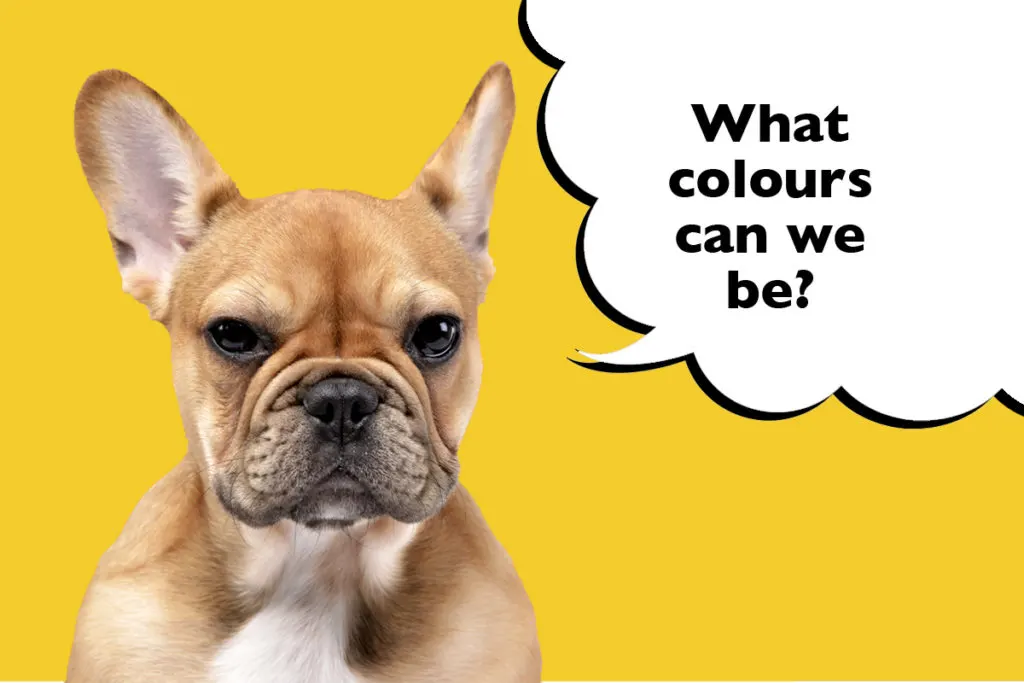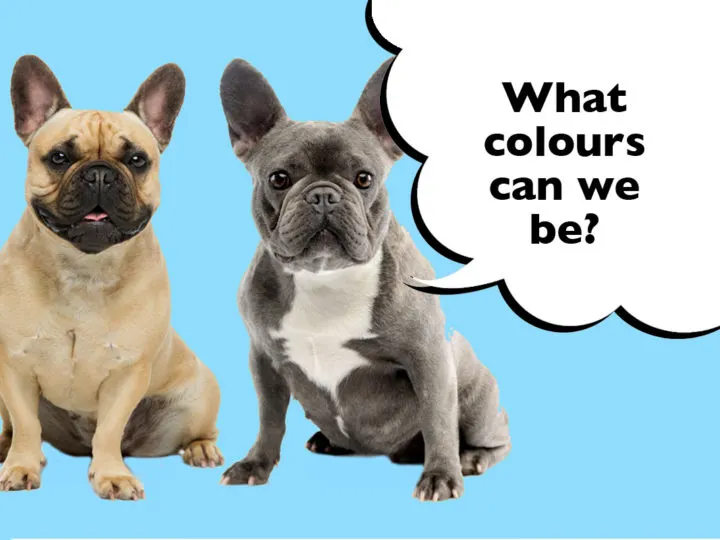Are you thinking of getting a French Bulldog and want to find out about all the different coat colours? Maybe you’ve heard about the health risks of dilute coat colours and what to know which ones to avoid? Here’s everything you need to know about the coat colours of French Bulldogs.
What Colours Can French Bulldogs Be? French Bulldogs can be Brindle, Pied or Fawn. These are the main colours but there are variations within them. Brindle includes dark brindle, light brindle and brindle and white. Fawn includes fawn and white, fawn pied and fawn with a black mask.
Read on to find out about natural coat colours, dilute coat colours and the potential health issues related to certain coat colours.
Never use the advice in this article as a substitute for professional veterinary advice or treatment. I am NOT a Vet, qualified dog trainer or dog behaviourist. This article is based on research, personal opinion and experience of owning dogs over the last 12+ years.
How many different Coat Colours Do French Bulldogs have?
According to the UK Kennel Club, there are 9 Breed Standard Colours that are officially recognised in the French Bulldog breed:
- Pied
- Fawn
- Fawn and White
- Fawn Pied
- Fawn With Black Mask
- Brindle
- Light Brindle
- Dark Brindle
- Brindle and White
However, there are also additional Non-Breed Standard Colours.
This basically means the colour isn’t accepted under the Kennel Club ‘breed standard’, even though you may still be able to buy some French Bulldogs in these colours.
For example, Black and Tan, Blue, Blue with either Tan or Fawn, Brown, Brown with Tan or White markings, Sable, Sable with Tan or White markings, Red or Cream.
These Non-Breed Standard Colours can also have markings or patches within the coat pattern.
The American Kennel Club (AKC) is slightly different. Their breed standard includes the following colours:
- Brindle
- Brindle and White
- Fawn
- Fawn Brindle and White
- Fawn and White
- White
- White and Fawn
- White and Brindle
- Cream
And for coat markings, the American Kennel Club accept:
- Ticked
- White
- Black
- Black Mask
- Piebald
- Brindle
The American Kennel Club do accept ‘White’ and ‘Cream’ coat colours within their breed standard, which is different to the UK Kennel Club.
French Bulldogs may also come in colours that are not considered standard for the breed that could potentially cause health issues in some dogs. These include:
- Blue
- Isabella
- Merle
- Lilac
Even though coat colour may be a consideration when buying a French Bulldog puppy, it’s more important to choose an experienced and knowledgeable French Bulldog breeder.
Always prioritise the welfare, health and temperament of the puppy, over the colour of their coat.
What Is The Most Common French Bulldog Colour?
Brindle is the most common colour for a French Bulldog.
The brindle coat is created with a combination of fawn and black hairs which tend to produce tiger like stripes on a French Bulldog’s coat.
If the black hairs are more predominant, then the French Bulldog will be darker.
Those that are lighter shades of Brindle, will have predominantly more fawn hairs. This is sometimes known as ‘reverse-brindle’ and tends to be less common than the darker shades.
French Bulldogs can also have white markings alongside their brindle colouration too, provided that Brindle is the dominant colour.
With any Brindle coloured French Bulldog, their eyelashes, edge of their eyelids and lips are all usually black.

What Is A Fawn French Bulldog?
A fawn French Bulldog is any shade of tan, ranging from light to dark. Their coats can be a very light almost cream shade all the way up to a deeper red tan colour.
They too may have white markings, providing that the fawn colouring is predominant. Some Fawn French Bulldogs may also have darker mask type markings on their faces too.
Unlike Brindle, Fawn is a recessive gene, making it less likely for puppies to be born with fawn coats if only one of their parents carries the Fawn producing gene.
That means that if a Brindle French Bulldog is bred with a Fawn French Bulldog, it’s more likely that their puppies will be Brindle coated, than Fawn.
What Is A Pied French Bulldog?
A Pied French Bulldog has a white coat with darker coloured patches. Each Pied French Bulldog will have completely unique markings.
A Pied French Bulldog’s darker markings can appear all over their body, legs, head and face.
Their darker markings can be made up of brindle or fawn coloured patches and it’s unlikely for them to have ticking or small spotted markings within their white coat sections.
The eyes, edges of the eyelids and lips of Pied French Bulldogs are generally black or very dark.
What Is A Blue French Bulldog?
A Blue French Bulldog has a silvery grey coloured coat. They tend to be a very popular colour amongst owners, even though they’re a Non Breed Standard colour (NBS).
They may have blue eyes instead of the traditionally darker eyes that are more common in other recognised French Bulldog coat colours.
A Blue French Bulldog may have a lighter grey coloured nose and lips, instead of the usual black colour.
Unfortunately, Blue French Bulldogs can be more prone to inheriting a condition known as CDA or Colour Dilution Alopecia. This can cause hair loss, flaky and itchy skin and other skin conditions.
Not all Blue French Bulldogs suffer from this condition, but there are many that do.
It often requires life-long treatment and can cause a great deal of irritation and discomfort for your French Bulldog if they suffer with CDA.
What Is A Merle French Bulldog?
A Merle French Bulldog has a mottled coat usually made up of various shades of black, blue and white hairs. Merle is a coat pattern as opposed to a specific colour.
Each Merle French Bulldog’s coat will be totally unique and individual. They may have blue eyes, or even one blue and one brown eye, which is known as Heterochromia.
It’s vital that two French Bulldogs with Merle coats are not bred together to try and produce more Merle puppies.
This is highly likely to create ‘double-merle’ puppies who often have long term hearing and vision impairments.
Merle French Bulldogs are not an accepted or regcognised colour with either the UK or American Kennel Club.
What Is An Isabella French Bulldog?
An Isabella French Bulldog has a diluted liver coloured coat.
They tend to be extremely rare as this is a difficult colour to produce, given the genes that create it are so recessive.
Isabella French Bulldogs usually have lighter coloured noses and lips, than other colours of French Bulldogs. Their nose and lip colour range from very light brown to pink and they tend to have either light blue eyes or light brown eyes.
Similarly to Blue French Bulldogs, Isabella French Bulldogs can also inherit Colour Dilution Alopecia or CDA. This condition is commonly seen in dilute coloured dogs.
Isabella French Bulldogs are a diluted version of liver coloured coats, whereas Blue French Bulldogs are a diluted version of black coloured coats.

Do White French Bulldogs Have Health Issues?
White French Bulldogs can be more prone to suffering from serious and complex health issues. This could include vision and hearing issues, skin conditions and increased sun sensitivity.
In the UK, it’s not acceptable under the Kennel Club breed standard, to have a completely white coated French Bulldog. Even Pied French Bulldogs shouldn’t be predominantly white.
However, in the US, the American Kennel Club (AKC) do accept completely white coated French Bulldogs.
What Are The Rarest French Bulldog Colours?
Blue, Merle, Lilac, and Isabella are the rarest French Bulldog colours.
This is because these colour genes are recessive, meaning it would take both parents of the French Bulldog puppy to carry these genes to be in with a chance of producing a puppy in this colour.
So, for example, if a female French Bulldog who carries the brindle and merle genes is then bred with a male French Bulldog who carries the same brindle and merle genes, then it’s likely they will have mostly brindle puppies.
Brindle is a dominant gene and Merle is recessive. So, even though they both carry the merle gene, this doesn’t automatically mean that the puppies will be merle coated.
Another reason that these colours are rare is because they’re not recognised by either the UK or American Kennel Club.
Therefore, registered responsible breeders are less likely to intentionally breed these colours, meaning there are less of them to buy.
Breeders that intentionally breed these coat colours don’t tend to put the puppy’s health first, instead choosing looks over their health and wellbeing.
Of course, it doesn’t mean they’ll all be born with health issues, but some will.
Why Are Some French Bulldog Colours More Expensive?
Some breeders choose to sell ‘rare’ coloured French Bulldogs puppies for a higher price than the standard breed colours.
However, you should always be cautious of breeders who charge more for particular colours of French Bulldogs, as they may not always be breeding healthy puppies.
If their focus is placed solely on breeding for looks and profit, they could overlook more important factors, such as the health of their parents. This can put the puppies at increased risk of genetic health conditions.
So, always look for a good breeder that puts the health and welfare of the puppy first, and don’t get pulled in by the rare and unusual coat colours!
So there you have it! French Bulldogs come in a variety of coat colours and patterns. Some coat colours are breed standard, some are non-breed standard, and some have health problems associated with them. The best thing you can do is get your new puppy from a reputable and registered dog breeder, to ensure their health and wellbeing is being put first.
What do I do next?
Thank you for reading all the way to the end of this article, your support for my blog means everything to me! If you found this article helpful, please kindly share below. Thank you!

